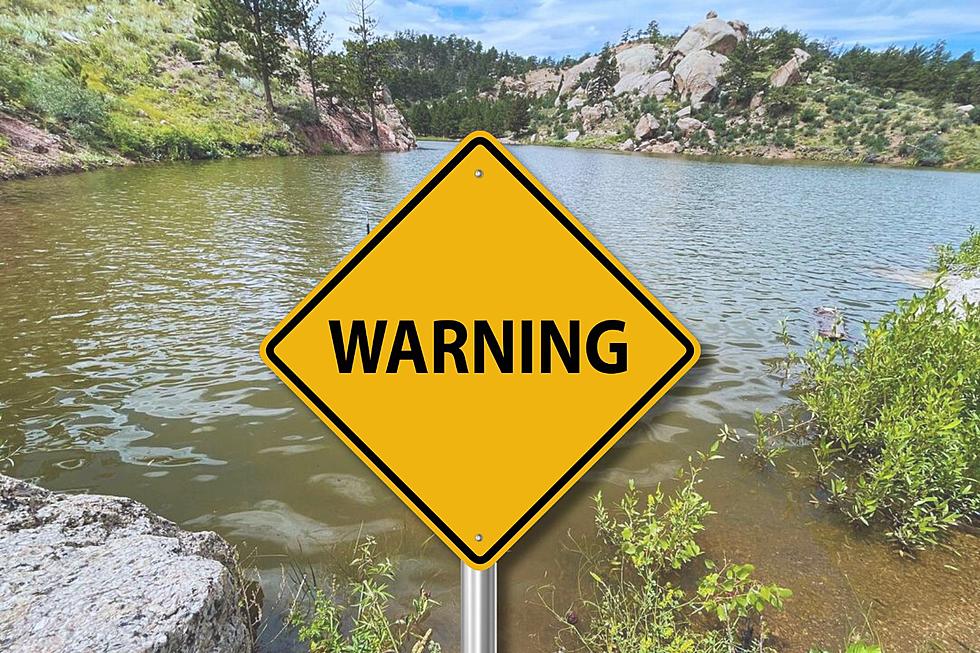
Toxic Algae in Wyoming’s Granite Reservoir? What You Need to Know
Visitors to Curt Gowdy State Park may need to adjust their fishing and boating plans in the coming days. On Wednesday, August 10, the Cheyenne Board of Public Utilities announced via Facebook that harmful cyanobacteria have developed in the park.

What Are Cyanobacteria?
Cyanobacteria, or cyanobacterial blooms, are also known as blue-green algae. Deposits of cyanobacteria typically form in the warmer, slow-moving waters of late summer. Cyanobacteria can produce harmful toxins that can prove deadly to humans and animals.
What Areas of Curt Gowdy Are Impacted by the Cyanobacteria?
According to the post, the cyanobacteria currently impact only the Causeway portion of Granite Reservoir. "The Causeway is an area west of the Granite Springs Reservoir where Middle Crow Creek flows toward the reservoir. The Causeway is separated from the main reservoir by a road," explains the BOPU.
The BOPU adds that it will continue to monitor the situation at Curt Gowdy. Currently, only the Causeway is impacted by the cyanobacterial blooms. The BOPU noted that "cyanobacteria was not detected in the main reservoir, a source for Cheyenne's drinking water."
Is the Algae in Granite Toxic?
You can't identify if an algae is toxic by appearance. The CDC explains that it's best to assume a bloom is toxic if you see one. The CDC website states, "If you see a bloom, stay out of the water and keep your pets and livestock out of the water. You cannot tell if a bloom is harmful by looking at it, so it is best to use caution and stay away."
Cyanobacteria can produce harmful toxins when ingested, inhaled, or touched.
Can You Still Fish, Boat, & Swim at Granite?
The BOPU's recommendations for avoiding the algae include not ingesting water in the impacted area and avoiding contact with the water in the area of the bloom. With that in mind, visitors should proceed with water-based activities with immense caution in the vicinity of the Causeway.
The CDC notes that illness from cyanobacteria commonly occurs if people or animals:
- Swim, wade, or play in or near contaminated water
- Eat contaminated fish, shellfish, or supplements
- Drink contaminated water
The main reservoir currently is not impacted by the growth - no advisory is in place for the main reservoir's water-based activities at this time. For updated advisory locations, visit the WyoParks advisory page here.
How to Identify Cyanobacteria (Blue-Green Algae):
It's important to know that you can't identify if an algae is toxic by appearance. However, you can usually make an educated guess on if a growth in the water is algae. The Centers for Disease Control offers the following information on identifying cyanobacterial blooms:
- Color: Usually blue-green in color but can appear red or brown.
- Appearance: Looks like floating scum, foam, or paint on the water's surface. When a bloom occurs, scum might float on the water's surface.
- Smells Like: Rotting plants.
For more information on cyanobacteria from the CDC, click here.
If you suspect growth in the water is a harmful cyanobacterial bloom, contact the Park Rangers and the local Board of Public Utilities immediately.
How to Avoid Cyanobacteria:
The BOPU recommends visitors to the reservoir do the following to avoid contact with the harmful algae:
- Avoid contact with water in the vicinity of the bloom, especially in areas where cyanobacteria are dense and form scum.
- Do not ingest water from the bloom. Boiling, filtration and/or other treatments will not remove toxins.
- Rinse fish with clean water and eat only the fillet portion.
- Avoid water spray from the bloom.
- Do not allow pets or livestock to drink water near the bloom, eat bloom material, or lick fur after contact.
- If people, pets, or livestock come into contact with a bloom, rinse off with clean water as soon as possible.
Signs of Harmful Algae Exposure:
The CDC notes that symptoms of harmful algae exposure depend on the type of cyanobacteria you've been exposed to. Symptoms include:
- Microcystins: abdominal pain, nausea, vomiting, headache, diarrhea, sore throat, blistering around the mouth, and pneumonia.
- Cylindrospermopsin: gastrointestinal symptoms, including vomiting, bloody diarrhea, fever, and headache.
- Anatoxin-a: neurologic symptoms, including numbness, tingling, burning sensation, drowsiness, salivation, and speech disturbances.
If you suspect exposure to cyanobacteria, seek medical attention.
What To Do If Exposed to Blue-Green Algae?
The Wyoming Department of Environmental Quality urges immediate action with exposure to cyanobacteria: "If people, pets, or livestock come into contact with a bloom, rinse off with clean water as soon as possible and contact a doctor or veterinarian."
